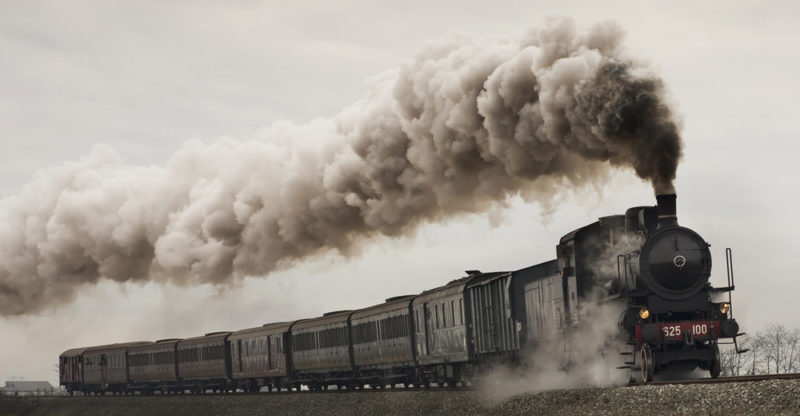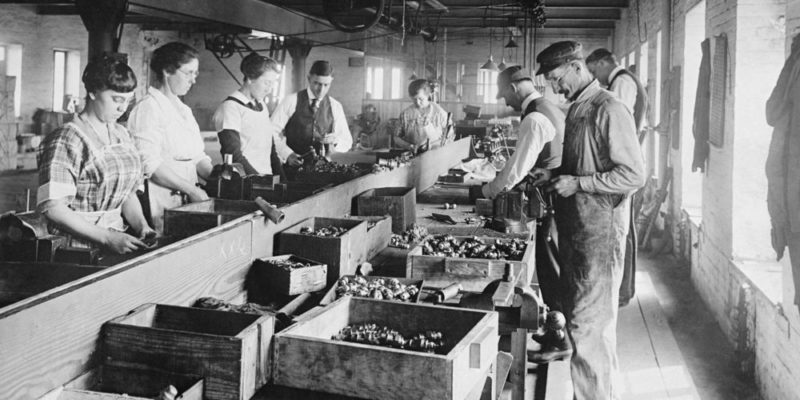We explain what industrialism is and how it was the context in which it originated. Also, what are its characteristics, and what is developmentalism.
What is Industrialism?
Industrialism is the organization of mass production for its capitalist use. Historically it meant a gradual change but accelerated replaced economies based on agriculture and handicraft production in an economy aimed at large-scale production through the work wage earner.
Although trade also existed in agricultural economies, industrialism makes it a central element that allows the sale of the large volume of goods produced.
Industrial production has existed since the mid-18th century and continues to this day. Since its inception, this type of production has depended on technological innovations, which is why it continues to be associated with scientific and technical research. The innovative technology also modifies the structure of each industry.
Characteristics of industrialism :
Source
 Industrialism originates from the industrial revolution. This revolution involved a series of large-scale changes that occurred initially thanks to technological advances but that affected the economy as well as society and culture.
Industrialism originates from the industrial revolution. This revolution involved a series of large-scale changes that occurred initially thanks to technological advances but that affected the economy as well as society and culture.Although it was an accelerated process, this “revolution” did not have a specific beginning and end, but rather developed from the mid-18th century in England to the mid-19th century, spreading first throughout Europe and then throughout the rest of the world. world.
Mass production
The main goal of industrialism is to achieve mass production of a diversity of products. Unlike artisanal production, industrial production is characterized by the ability to deliver large quantities of identical products to the market in a short time.
Main inventions
 To achieve mass production, industrialism has used from the beginning the implementation of new technologies. The first technological innovations that marked the origin of the Industrial Revolution were the steam engine and the power loom.
To achieve mass production, industrialism has used from the beginning the implementation of new technologies. The first technological innovations that marked the origin of the Industrial Revolution were the steam engine and the power loom.The steam engine was not only used as a mechanized way of speeding up production but also when applied to transport with the invention of the locomotive, it allowed the transport and distribution of the new goods produced.
The so-called Second Industrial Revolution, which occurred in the second half of the 19th century, was driven by other technologies: steel, electricity, and oil. Today industries continue to depend on 19th-century technologies, but they are renewed mainly by innovations in informatics and chemistry.
Salaried work
 Industrialism modifies the employment situation of various sectors of society. First, industrial work always requires a certain amount of wage labor, that is, workers who are paid for their working time.
Industrialism modifies the employment situation of various sectors of society. First, industrial work always requires a certain amount of wage labor, that is, workers who are paid for their working time.Depending on the industry in question, more or less amount of labor of various qualifications will be required. For example, the tourism industry requires a small amount of skilled labor and large amounts of labor with little to medium training.
For this reason, industrialism can be a solution to unemployment. But on the other hand, industrial products are in competition with artisan products. If they are displaced from the market, the artisans will be forced to become wage laborers as well.
Urbanization
The Industrial Revolution occurred in England at a time when rural people were migrating to the cities in search of work. The employment of salaried labor and the concentration of people in urban centers were two factors that complemented and fostered each other: as industrialization advanced, more people migrated to the cities, and in this way, more industries could grow.All industrial societies have high population concentrations in urban centers. However, currently, it aims to create industrial sectors close to cities but outside of them.
Pollution
 In the early stages of the Industrial Revolution, the use of coal and later oil as energy sources for factories did not seem to have disadvantages. However, we currently know the polluting effects of the use of fossil fuels. Other industries, such as the metallurgical industry, emit other toxic substances such as sulfur.
In the early stages of the Industrial Revolution, the use of coal and later oil as energy sources for factories did not seem to have disadvantages. However, we currently know the polluting effects of the use of fossil fuels. Other industries, such as the metallurgical industry, emit other toxic substances such as sulfur.Currently, there are forms of industrialism that try to reduce the negative impact on the environment, controlling toxic emissions, using clean sources of energy, and minimizing their waste through recycling.
Heavy and light industry
 Heavy industry is one that is dedicated to building machinery that is used in other industries. Industries that manufacture consumer products are called light industries.
Heavy industry is one that is dedicated to building machinery that is used in other industries. Industries that manufacture consumer products are called light industries.Industrialist processes usually begin with light industry, in order to offer jobs and local products to the population. But the industrialist processes that aim to become independent from other producers and to have more control over prices also advance the establishment of heavy industry.
This type of industry requires greater investment and also access to raw materials such as metal or oil.
Developmentalism
Developmentalism is a political theory that emerged in the mid-twentieth century in Latin America. This theory holds that governments must actively promote industrialism in their countries to enable them to achieve an autonomous economic situation.Before the emergence of developmentalism, in general, the countries of Latin America functioned as suppliers of raw materials for industrialized countries and bought industrial products from other countries.
Internal - external consumption

Crisis of Industrialism
Until the middle of the 20th century, 95% of capital investment was in productive activity. However, from successive crises and devaluations of currencies initiated in 1967, investment moved heavily towards the financial market. This market is speculative and only a portion of the capital is used directly in the productive sphere.The above content published at Collaborative Research Group is for informational and educational purposes only and has been developed by referring to reliable sources and recommendations from technology experts. We do not have any contact with official entities nor do we intend to replace the information that they emit.
MA student of the TransAtlantic Masters program at UNC-Chapel Hill. Political Science with a focus on European Studies. Expressed ideas are open to revision. He not only covers Technical articles but also has skills in the fields of SEO, graphics, web development and coding. .
Leave a reply
Your email address will not be published. Required fields are marked *Recent post

Sport: What Is It, Types, Risks, Features, Characteristics and Examples

Dogs: Emergence, Features, Characteristics, Feeding and Breeds

Story: Definition, Elements, Structure, Features and Characteristics

